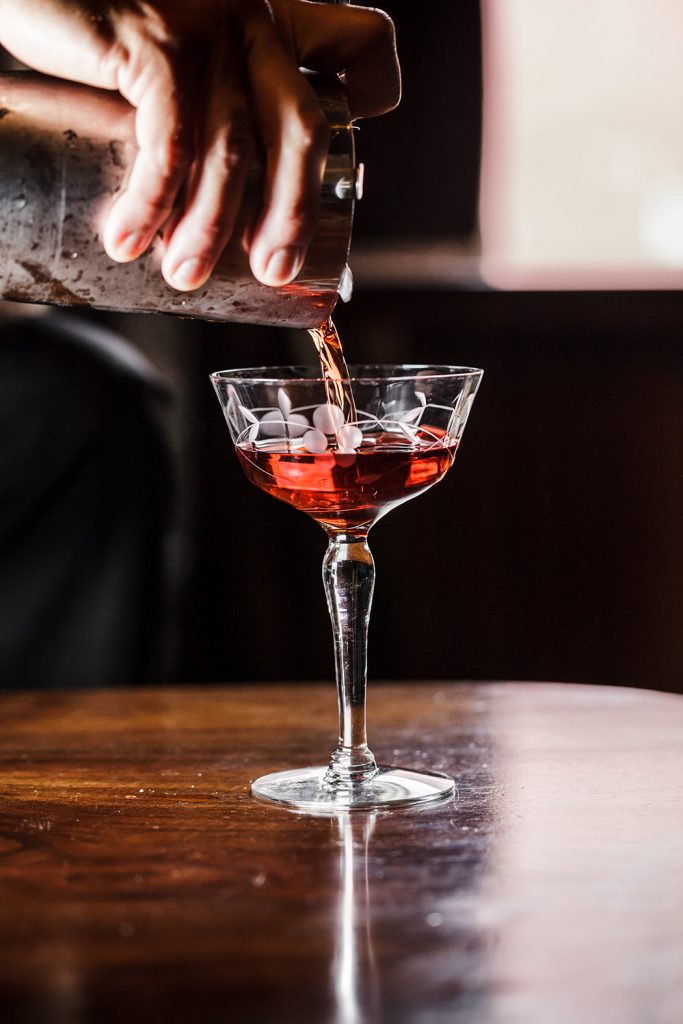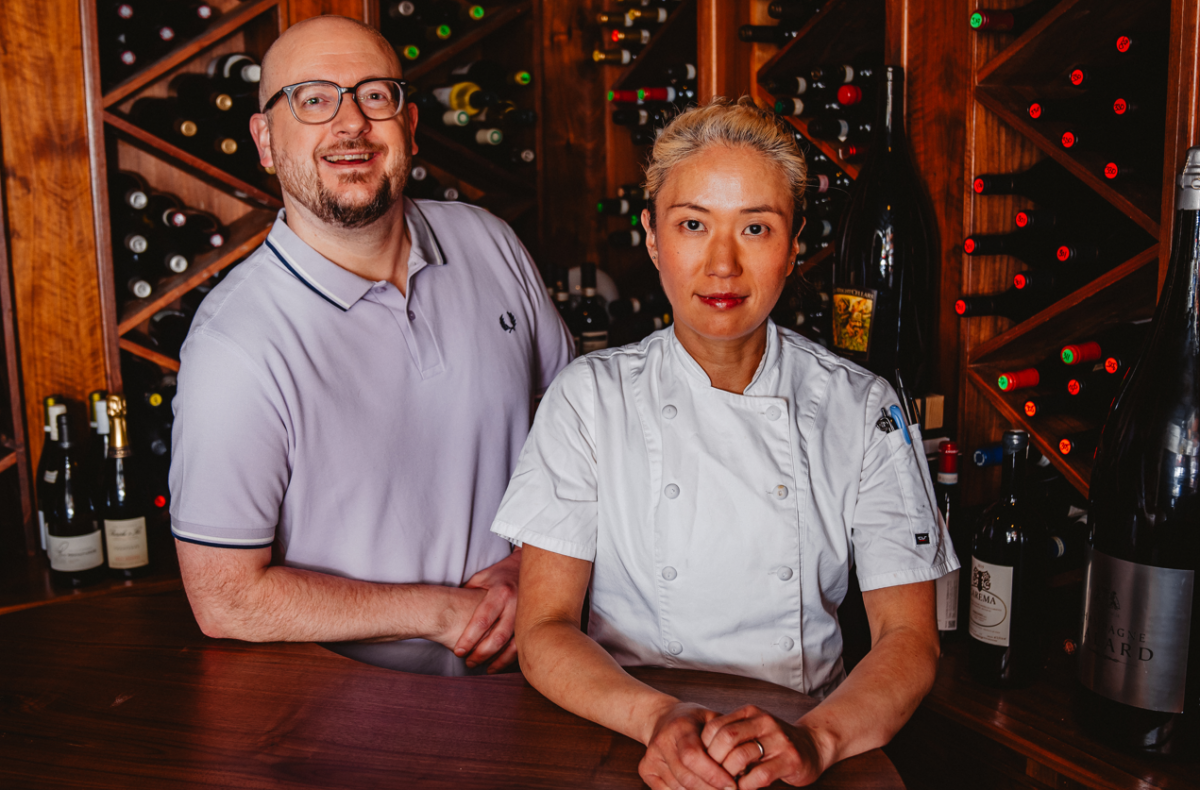Small and unassuming, the original Harry’s Bar in Venice, Italy, has served classic cocktails to celebrities and locals since 1931. The Alley Light restaurant owners, Chris Dunbar and Robin McDaniel, say it inspired Charlottesville restaurateur Wilson Richey when developing their intimate spot on Second Street SW.
“Will went to Europe a lot, and … Harry’s Bar is a place that he used to always reference. I think that was where the no sign thing kind of originated,” says Dunbar. “He always talked about how he wanted a place to have a proper cocktail, kind of a lounge setting, a little private, sort of off the path.”
It all took shape, “likely at a dinner party” with renowned chef José DeBrito, who quickly refined the menu concept from lounge fare to skillfully composed country French dishes, says Dunbar. Married couple McDaniel and Dunbar, along with DeBrito, joined The Alley Light team at the beginning. The three worked together at Fleurie, and when The Alley Light’s doors opened in February 2014, McDaniel was its pastry chef, and Dunbar took front-of-house duties a few months later.
Also on the opening staff was bartender Micah Lemon who, despite having an undergrad degree in science and a master’s in linguistics, says he sought out bartending. Lemon had been developing his mixology through experimentation and intensive projects, (such as bottle-conditioning ginger beer for Blue Light Grill). Once tipped off to Richey’s plans, he told him: “I’m into cocktails, and I kind of like to make things yummy and spend hours doing it.”
The opening of The Alley Light was a move that brought new energy to local upscale drinking and dining. DeBrito’s culinary talent had followers, and craft-cocktail lists had been shaking things up on metro scenes since the early 2000s. DeBrito’s elegant petit plats paired with Lemon’s innovative drinks created an immediate buzz.
Then in 2015, the James Beard Foundation nominated The Alley Light for Best New Restaurant, and Washington Post food critic Todd Kliman came to town to see what the fuss was about—and left a three-star review. The attention was a game changer. “Once we got the JB award nomination, it codified that we were good at something, and established a reputation that we made good things,” says Lemon.

Richey was a skilled restaurateur, who, to the devastation of the area’s food community, lost his life in a December 2023 car accident. At the time of his passing, he had nurtured several notable restaurant concepts into service, and fostered many careers. A big-idea man, Richey was a vivacious collaborator who believed in his people, tapped their talent, and gave them opportunities. In 2016, he sold The Alley Light to Dunbar and McDaniel.
“Will had established a pattern of opening up ownership to his restaurant team,” says Dunbar. “He had other projects and sped up the process to allow [our] buying Alley Light.”
Just a few months into new ownership DeBrito left for an opportunity at triple-Michelin-star legend The Inn at Little Washington, and McDaniel stepped into her first job as head chef.
McDaniel studied art and design, but always felt the pull of restaurant kitchens. “The running joke in art school was that I should be in culinary school,” she says. After graduating, she returned to Charlottesville, looking to cook and learn solid technique. It was as front-of-house manager at TEN, where McDaniel says she worked a few sushi bar shifts, and made her foray into cooking.
Focused and calm, McDaniel credits her natural ability to a balance of versatility and perfectionism, plus working under DeBrito, who taught her that “things are never fast, and the more work it is, the better it’s going to be,” she says. The evidence is all over her menu, where she pushes beyond pastiche with dishes such as chilled jumbo lump crab, watermelon, heirloom tomato, and prosciutto with lime-basil sorbet. A seasonal dish she runs only when she “can get the good tomatoes.”
Ten years in, it’s hard to decide what’s most alluring about The Alley Light. Is it seeking out the restaurant in its titular location? Or perhaps it’s the warm welcome into its cozy, loungelike dining room. But maybe it’s scanning the chalkboard of rotating menu items that reads like culinary poetry, or perusing the sophisticated cocktail list curated by Lemon and his team.
“There’s a lot of things that go into The Alley Light,” says Dunbar. “The atmosphere, cocktails. The attention to detail. Micah’s attention to detail. Robin’s attention to detail.” Mostly, he says, the restaurant works because The Alley Light asks its patrons to be adventurous. McDaniel says diners have grown into the food—beef cheeks and sweetbreads are popular. One young regular often dines on the bone marrow.
Sometimes it’s a customer who asks the staff to be adventurous. “The first couple years we were open, people just brought us weird things,” says Lemon. “One day, some dude brought José bear meat and wanted him to cook a bear steak.” The bear meat didn’t make it onto the menu, but DeBrito did oblige the patron.
Back-of-the-house adventures are more likely to be controlled chaos. “I think that’s what I find so exciting,” says McDaniel, whose tiny kitchen went without a stove for the first five years. “There are so many things that can go wrong.” For example? “The radish snack,” she says. “It’s the most simple, but it has to be perfect, and it will put you in the weeds. Everything is cut to order.”
After discussing drink recipes that include a calamondin sour, a ramp martini, and a stick cocktail, Lemon downplays his process. “Whatever bells and whistles you have on your plate or in your cocktail, it has to be fundamentally, unimpeachably tasty, or what’s the point?”
It’s about “tasting a time and a place,” he says. “I want people to appreciate coming here in June, and having a bourbon peach sour from The Alley Light.”













